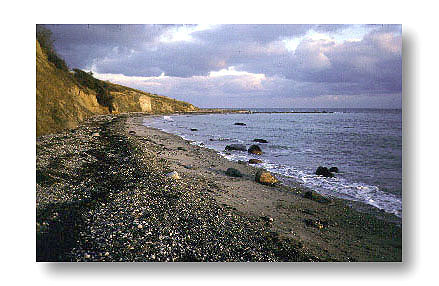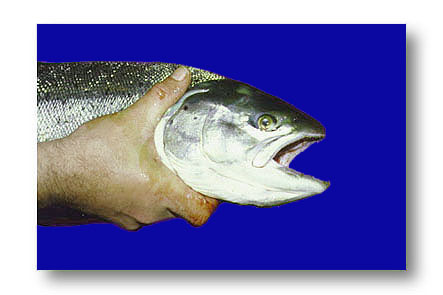|
A novice fisherman should therefore be
prepared to invest a certain amount of time - in reconnaisance
and study - before he starts catching fish!

- It all starts in freshwater
where spawning takes place.
- © photo Steen Ulnits
Several external factors rule the life
of a seatrout. Knowledge of these factors will highly increase
the catches of any fisherman, be he a spinning addict or a flyfishing
fanatic. Two of the most important factors are food and the physical
condition of the water. Where food can be found, seatrout will
be present too! After all, food is the primary reason for the
trout migrating into the sea.
For that reason it is very important that
visiting fishermen keep an eye open for food items present in
the piece of water that he has chosen to fish. If he sees fleeing
baitfish, hiding crustaceans or wiggling worms, he is on the
right track. Then sooner or later seatrout will be there too.
But if he sees nothing, chances are that there will be no seatrout
either.
If you want to catch seatrout on a regular
basis, you have to know about their annual migrations and changing
habitats. Seatrout migrate a lot - most along open shorelines,
least in secluded bays. They are either following bait or migrating
back and forth between their spawning and their feeding grounds.
Thus we are dealing with two seemingly
different kinds of seatrout - one that wants to feed and one
that wants to spawn.
Spring
In early spring the spring migration begins
- from freshwater or brackish water into the open sea. The exact
time for this migration depends on both the time of year, the
location and the prevailing water temperature.

- In early spring sea
trout stay in brackish bays like this.
- © photo Steen Ulnits
If the winter is mild or the water brackish,
the migration from the rivers and secluded bays may begin early
in the year. But after a cold winter or in places with a high
salinity, migration will begin later - typically in March-April.
And if spring sets in suddenly, migrations may start - and end
- very quickly. Following a mild winter, migrations will start
more slowly and will last longer.
If the winter has been long and cold -
with ice covering the water - you may experience fantastic fishing
just after iceout. A large number of fish will have congregated
in the brackish bays, where they are very hungry. And since food
is still scarce, the fish are easy to catch. Conversely, after
a mild winter fish will be spread over a larger area - many in
the open sea at an early time. Here they are more difficult to
locate - and catch.
After spawning seatrout quickly regain
the weight they lost in freshwater. Often the spawned-out "kelts"
are followed by a different kind of seatrout - the small but
fat and silvery "grønlændere" who are
immature seatrout that have not spawned yet. Unfortunately, they
are often just under the legal size limit of 40 cm's and thus
have to be returned unharmed.
"Grønlændere" may
never have entered freshwater during the winter months. They
may have stayed in brackish water all winter where they have
been feeding actively. Come spring they follow the bigger seatrout
out into the open sea where they feed voraciously on baitfish,
crustaceans and worms.
Summer
When the water temperature rises, so does
the seatrout's tolerance towards the salinity of the water. During
the warm summer months the seatrout has no problems whatsoever
with true oceanic water - with a salt content as high as 35 o/oo.

- Come summer, sea trout
will be in salty ocean water like here on Djursland.
- © photo Steen Ulnits
But water temperature can get too high
for seatrout. When it approaches 20 degrees Celsius, seatrout
escape the heat by migrating out towards deeper and colder water.
This typically happens in July which marks the coming of true
summer. May and June still offer excellent seatrout fishing for
those willing to fish through the night - during the "light
nights" as we call them in Denmark.
But the warm coastal waters of summer still
hold an abundance of food. Seatrout know that and seek the shallows
at night time when the water is at its coldest and prey most
active. Come sunrise, seatrout again abandon the shallows and
seek the cold of deeper water.
If you want to catch seatrout during the
heat of summer, it has to take place during the darkest hours
of the night. If you have access to a boat, you can seek the
fish in deeper water during the day. Unfortunately, seatrout
out here are often digesting the food they ate during the night.
Thus they are not very interested in eating any more - until
after the next sunset.
Daytime fishing can still be productive
though - at places where strong currents and deep water meet
within reach close to shore.
Autumn
Spring and summer have been used to grow
fat and ready for the spawning migration of autumn. This migration
is often triggered by the first storms and rainfalls of August-September.
Immediately the fish sense that autumn is around the corner -
spawning season too.
Most of the larger fish have already left
the sea and entered the rivers in May-June. The majority of smaller
fish stay in the salt for an additional few months and do not
start the spawning migration until now.
Often they congregate in smaller schools
of similar sized fish. Some males and females may already have
teamed up in pairs. If you meet groups of mature seatrout like
these, you may be in for the best and most exciting fishing of
the year!
Don't be afraid of inclement weather when
it comes to fishing for these lightly coloured fish. In fact
the fishing typically improves as the weather gets worse. Calm
and sunny weather usually makes these fish almost impossible
to catch. But inclement weather really turns them on!
Often these mature fish of autumn can be
caught in exactly the same spots where the spawned-out kelts
of spring were encountered. And often it pays to fish during
night time where migrations mostly take place.
Points projecting from the coastline are
always the best bet. Here the fish often stop for a break during
their migration.
Winter
Come winter, all mature seatrout have left
the salt and entered the rivers. Still you may encounter small
immature "grønlændere" or large "overspringere"
- fish that for some reason have chosen not to spawn that particular
year - in the ocean. The latter form sort of a reserve if some
diasaster should wipe out all fish in the river.
These silvery and immature fish continue
their nonstop feeding in the salt as long as the water is warm
enough and the food plenty enough. As the water temperature drops,
the fish seek from the salty open sea into secluded bays where
freshwater outlets have made the water more brackish. Here they
will spend the winter. They are still feeding but their appetite
drops with the dropping water temperature. Thus they become more
difficult to catch.
It is very difficult to generalize about
the effects of water temperature on fish behaviour. This is especially
so when the salinity of the water has to be taken into account
too. But if we are to do it anyway, then always and if possible
avoid temperatures below 5 degrees. If the water temperature
is somewhere in between 5 and 15 degrees Celsius, seatrout thrive
- no matter how high the salinity.
In the wintertime, open and salty waters
are usually devoid of seatrout. They have either left to spawn
in the rivers, or they have sought more brackish water in the
bottom of secluded bays. This is where we find them when winter
is giving way to spring - after iceout. From then on their appetite
just grows and grows, often resulting in pure feeding frenzies
on warm sunny days.
Not surprisingly the best early spring
fishing is usually to be had on sunny days where the water really
has picked up some warming rays from the sun. Shallow water normally
produces most fish as it warms faster than deeper water.
When the upcoming spring migration has
spread the seatrout over a larger area, they have again become
more difficult to find - and catch. But they still hunt aggressively
- if you encounter them. And come the heat of summer, the places
used for overwintering have often become muddy and depleted of
oxygen - now totally unattractive to the fish.
The year of the seatrout has come to an
end - and a new has begun!
"Bay trout"
and "herring feeders"
In larger bay areas you may come across
a type of seatrout that does not follow the Year of the Seatrout.
It is the so-called "fjordørred" - "bay
trout" - which resides permanently in the bay all year round.
Quite often it never turns silvery like most seatrout. Instead
it retains a golden hue with lots of black spots all year round.

- Big sea trout like this
4 kg specimen become exclusive herring feeders.
- © photo Steen Ulnits
Occasionally you may even encounter a bay
trout with remaining red spots - a leftover from its time in
freshwater. A good example of the fact that seatrout and brown
trout are in fact one and the same species - they just happen
to live in different environments. Bay trout feed mostly on smaller
baitfish and crustaceans - only rarely do they attack larger
fish.
The exact opposite goes for the so-called
"sildeædere" - "herring feeders" -
who do just that: Feed exclusively on large herring and sprat.
They may have the same parents as the bay trout but at some time
in life they decided for a different way of living.
When reaching a size of maybe 3-4 pounds,
small food items don't really fill up the stomachs of seatrout
any longer. Therefore they turn their interest towards larger
food items.
They migrate out into deeper water where
they lock on to schools of sprat, herring and sand eels. On this
new diet the seatrout start to grow very rapidly. They have also
become fish that shoreline fishermen seldom encounter any more.
They live way out and deep down where only boat fishermen stand
a chance of catching them.
But they grow rapidly and reach sizes comparable
to salmon. Seatrout weighing 10-20 pounds are not unusual among
the schools of sprat, herring and sand eels!
© 2006 Steen Ulnits
|

